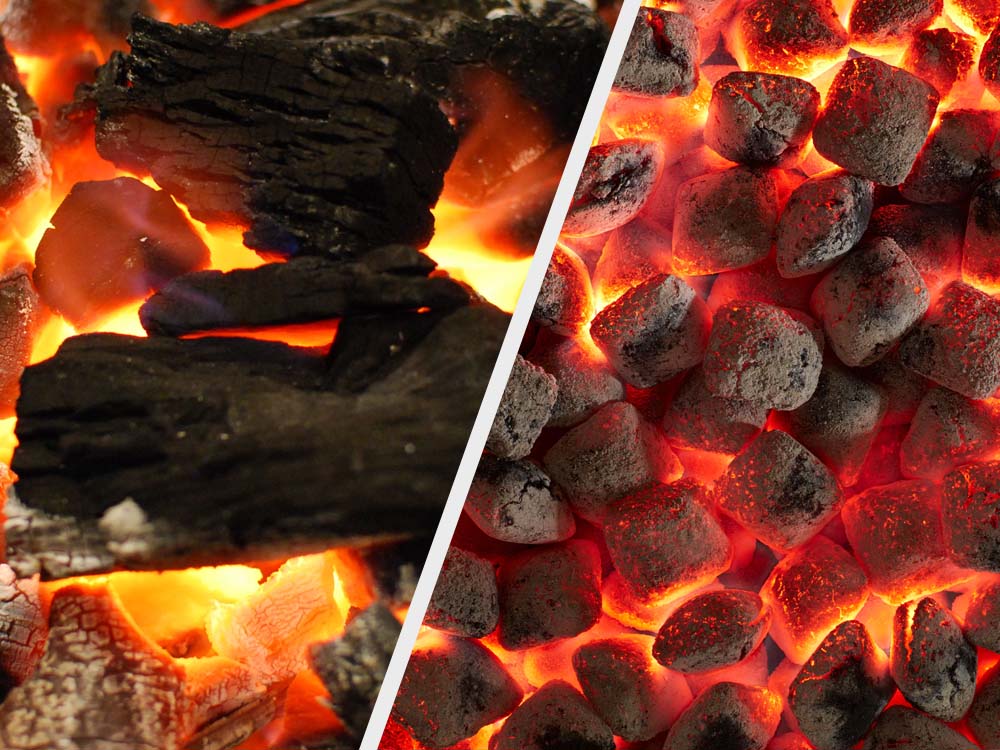When it comes to charcoal, there are two main types: Lump Charcoal and Briquettes. Both have their own unique properties, but there are also some subtle differences that all barbecue enthusiasts should be aware of.
Here we compare these two types of charcoal and discuss when is the best time to use each one. So keep reading if you're wondering which type of charcoal is right for your next BBQ!
Lump Charcoal vs Briquettes
The main difference between lump charcoal and briquettes is the raw materials. Lump charcoal is 100% hardwood and has no additives, whereas briquettes are made from compressed sawdust and often contains fillers and binders to hold them together in a uniform shape and size.
For most people, briquettes are the better choice as they are easier to light, provide a more even heat, and are cheaper to buy.

What's better?
Both lump charcoal and briquettes have their own distinct features, but one is often better than the other depending on the situation.
A good example is where you would use lump charcoal when you need a high heat for searing and barbecuing, or if you are after a lower heat for low and slow cooking then you would be better using briquettes.
Here is a quick comparison of the key features of the two:
| Lump Charcoal | Briquettes |
| Does not contain any additive (100% pure) | Contains additives and fillers |
| May reach a hotter temperature | Has a steady temperature |
| Burns faster | Burns for longer |
| Less ash production | Higher ash production |
| Irregular pieces of wood | Uniform size |
| Lights faster | Takes longer to light |
| More expensive | Cheaper |
Manufacturing Process
Lump charcoal is made by burning the wood slowly without any oxygen present until the sap, moisture, and natural chemicals have dissipated. Additionally, it uses hardwood pieces compressed together without using any binders, giving a natural and pure charcoal.
Briquettes are composed of leftover wood and sawdust that are then burned slowly without much oxygen to remove sap and moisture. Additives are also added that bind the charcoal together, giving it a uniform shape. In most cases the additives used are food-safe, such as starch and molasses.
Burning Time and Temperature
Lump Charcoal is designed to burn hot and fast for a short period of time - perfect for barbecuing and searing. It usually burns for around an hour and can reach temperatures up to 760°C.
Briquettes are made to burn for hours and are perfect for low and slow cooking or roasts. They have a steady temperature between 426-538°C and can burn for hours meaning you don't have to monitor it as much to add more charcoal because it burns much slower and lasts longer.
Ash Production
Both options produce ash when burned however there is a slight difference between the two - lump charcoal produces less ash than briquettes as it doesn't contain any fillers or additives..
Ease of Lighting
Generally briquettes are more manageable to light up than lump charcoal because of the additives, however they do take longer to light. Some briquettes can have a 'chemical' smell to them which usually goes away once the briquettes are at a cooking temperature (white in colour and ashed over). Good quality briquettes don't have this issue but some cheaper ones do.
Longevity
Lump charcoal burns much faster so if you are cooking for an extended period of time (such as a roast) then you may have to add more fuel during the cook for a continuous burn. This can get expensive as you will burn through more fuel and may need more than one bag if you are planning a longer cook.
On the other hand, briquettes burn for longer and at a more steady temperature. They are a much more suitable option on occasions where you are cooking for longer, like a roast or a low and slow cook. This also means you don't need to monitor the cook as much or add as much fuel halfway through a cook. Also, if you have leftover fuel at the end of a cook (and it is a good quality fuel), you can re-use larger briquette chunks by mixing them in with fresh fuel in your next cook!
Price
Lump charcoal is the more expensive option as they are more labour-intensive to produce, have more expensive raw materials, and has a limited availability.
For instance, lump charcoal is currently hard to source due to the recent flooding in NSW where the hardwood is sourced.
Briquettes are like the fast food of charcoal - they are cheap and can be commonly found everywhere including petrol stations, supermarkets, and hardware stores.
Appearance
Lump charcoal is made from pieces of wood of various shapes and sizes, which causes it to produce inconsistent fire.
Because briquettes are manufactured to a uniform shape and size (usually a roundish-square) they are easier to stack and often provide more even heating.
Flavour
Lump charcoal produces a better flavour, especially when it is made from specific hardwoods such as oak, hickory, maple, and pecan.
The wood flavour from briquettes can be less distinctive and some cheaper options may have a chemical aroma.
Performance
As mentioned above, lump charcoal burns hot and fast. This makes it ideal for direct barbecuing and searing. It is also responsive to oxygen making it easier to control the temperature by opening and closing air vents on your barbecue. If you really want to impress your guests, charcoal may also be the better option as it gives you more flavour.
Because briquettes burn consistently at a steady temperature for longer, they are ideal for longer cooks and smoking. Because they have a consistent shape, they are also great for setting up the 'snake method' when smoking as they are easy to stack.
Pros & Cons
Lump Charcoal
- Pros
- Lights quickly
- Burns hotter
- Adds a smokey flavour
- Less ash production
- Made from all-natural materials
- Cons
- More expensive
- Limited supply
- Produces inconsistent temperature
Briquettes
- Pros
- Steady & consistent temperature over long periods
- Easier to stack
- Burns longer
- More affordable
- Readily available, everywhere
- Cons
- Cheaper briquettes may have 'chemical smell and taste'
- Produces more ash
- Takes longer to light
Overall Winner
Lump charcoal is better when direct cooking, barbecuing, or searing. It produces a cleaner smoke and burns much hotter than briquettes.
Briquettes are easier to find and produce a longer, steady burn making them the better option when cooking for hours at a time while roasting, smoking, or low and slow cooks.
Now that you have the low-down on which fuel will give you the best results, what seasonings and marinades will you use to take your barbecue experience to the next level? For ideas and recipes check out Weber's BBQ Bible and Australia's Own Cookbook for the Weber Q.
Ultimately, the best choice of charcoal will depend on your needs and preferences. What are you cooking? How long are you cooking? How are you cooking it? Once you answer these three questions you'll know whether lump charcoal is the better option for that cook, or whether you should use briquettes instead.






Leave a comment